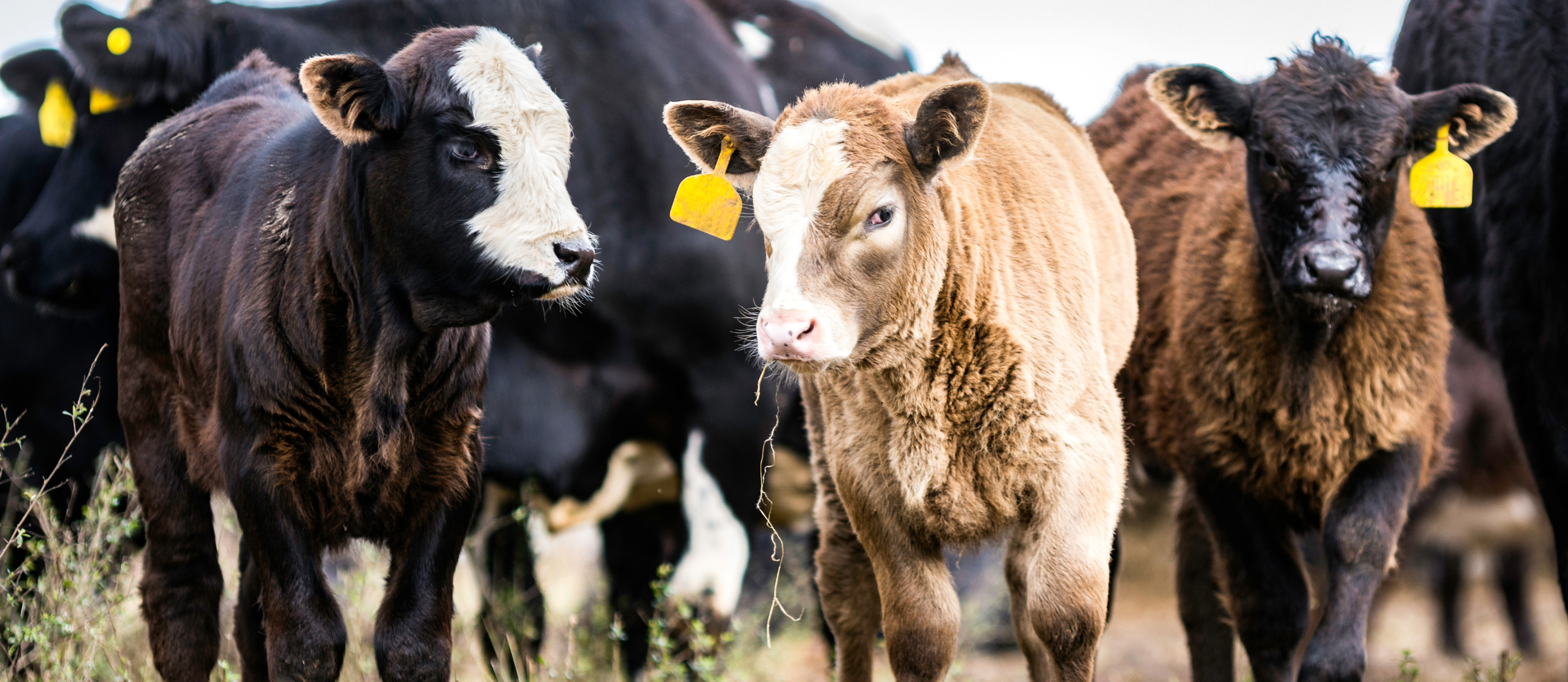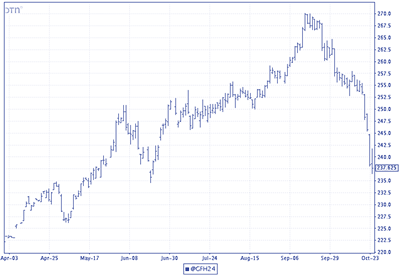Prospects for Winter Backgrounding 2023-2024
Prospects for Winter Backgrounding 2023-2024

After several years of cattle selling at frustratingly low price levels, continued herd liquidation has led to tight supplies and much higher calf prices in 2023. While markets have pulled back in recent weeks, calves and heavy feeders are moving at prices $50 to $70 per cwt above what was seen a year ago. Feed prices have also decreased over the last several months and most feeds will cost less this winter than last. Hay will likely be an exception in parts of Kentucky as a result of drought conditions. Hay markets tend to be much more regionalized due to high transportation costs, so significant hay cost differences can occur across regions. All of these factors should be taken into consideration when one considers placement of calves into backgrounding programs this fall.
At the time of this writing (October 24, 2023), March 2024 CME© feeder cattle futures were trading around $238 per cwt. As winter backgrounders consider purchasing calves this fall, these late winter futures prices provide market expectations for feeder cattle sale prices. With an early spring futures price of $238, and an estimated -$6 basis, an 800 lb feeder steer in Kentucky would be expected to bring around $1856 (800# @ $232 per cwt) in March. Of course, actual basis is heavily impacted by local market conditions, lot size, cattle quality, location, and numerous other factors. The -$6 basis discussed previously assumes that cattle are of relatively good quality and are sold in potload sized groups.
The AMS Kentucky Weekly Livestock Auction Summary for the week ending on October21st reported a state average price for 450-500 lb steers of $248 per cwt and a state average price for 500-550 lb steers of $245 per cwt. This market continues to evolve, and additional costs could be incurred putting together groups of calves for placement. For the purposes of the first table, we estimated the purchase price for a 500 lb steer at $255 per cwt, or something close to $1,275 per head. There is always a large range in calf prices, so individuals are encouraged to apply this process to the type of calves they typically buy.
We also need cost estimates on wintering those calves and selling them in the spring. While we provide an estimate for a specific winter program, costs will vary based on local conditions and the specific backgrounding program. Feed is the major cost and producers should consider all potential feeding options including commodity feeds, corn, and corn silage. For this scenario, we will consider a single program where calves are fed 1.5% of their body weight per day of a 3-way blend of corn gluten, soy hulls, and shelled corn and another 1.5% of their body weight per day of grass hay. While performance will vary, we will assume a rate of gain of 2.5 lbs per day, which would put on 300 lbs in approximately 120 days.
The 3-way blend is valued at $285 per ton and grass hay at $100 per ton. Health costs are assumed to be $28 per head, transportation costs are estimated to be $15 per head, and selling/marketing expenses are set at $25 per head. An interest charge of 8.5% is included and death loss is assumed to be 2.5% for 500 lb steers and 2.0% for 600 lb steers (discussed later in article). These costs will vary by location and operation, so readers are encouraged to come up with their own estimates.
Several of these cost estimates are worth careful consideration. For example, we have assumed selling/marketing expenses of roughly $25 per head, which assumes that producers are paying the reduced commission rates associated with large groups. However, many producers will be selling in smaller groups and likely paying higher commission rates on a per head basis. Vet and medicine costs are assumed $30 per head. With these caveats in mind, the following table shows expected returns to the program described above.
Table 1: Winter Backgrounding Budget Estimate
| Revenues | #units | unit | price/unit | total |
|---|---|---|---|---|
| Feeder | 800 | lbs | $2.32 | $1856 |
| Expenses | ||||
| Stocker Calf | 500 | lbs | $2.55 | $1275 |
| Hulls / Gluten | 0.585 | tons | $285 | $167 |
| Hay | 0.585 | tons | $100 | $59 |
| Mineral | 1 | head | $12.00 | $12 |
| Vet / Med | 1 | head | $30.00 | $30 |
| Selling / Marketing | 1 | head | $25.00 | $25 |
| Hauling | 1 | head | $15.00 | $15 |
| Other (water, etc.) | 1 | head | $12.00 | $12 |
| Interest | 8.5% | rate | $39 | |
| Death Loss | 2.5% | $34 | ||
| Total Expenses | $1671 | |||
| Return to Land, Capital, and Management | $185 |
As can be seen in table 1, projected returns are $185 per head this winter based on the assumptions discussed previously. Producers are strongly encouraged to modify these assumptions for their individual programs to better reflect calf values and expected spring basis, as well as cost estimates and feed prices for their area. It is also worth noting that labor, depreciation, and interest on owned capital are not included in the budget, so the return shown is a return to land, capital, and management. Producers should ask themselves if that return adequately compensates them for their time, capital investment, management, and risk.
The two key assumptions made in Table 1 include the cost of the calves being placed and the expected sale value in the spring. Changes in calf placement costs will greatly impact winter backgrounding returns. For every $5 per cwt decrease in the purchase price of the calves, the return to land, capital, and management increases by $25 per head. The second assumption, the sale price for the feeder steer won’t be known with certainty until spring. Note that the assumed spring sale price in the analysis is $232 per cwt and the projected return is $185 per head. A $23 per cwt decrease in sale price would result in actual returns falling to $0. While feed price does not have as large an impact on profit as sale price, a $25/ton decrease in the price of the 3-way blend would increase expected profit by $15, and vice versa.
Table 2 shows a side-by-side comparison of our assumed costs for placement of a 500 lb steer and a 600 lb steer. The same feeding and gain assumptions are made, but feed costs are higher for the 600 lb steer due to his increased bodyweight. A few other costs also increase, such as mineral, transportation and interest.
Table 2: Expected Variable Costs Fall 2023
| 500 lb Steer | 600 lb Steer | |
|---|---|---|
|
Feed |
$167 | $200 |
| Hay | $59 | $70 |
| Vet/Medical | $30 | $30 |
| Mineral | $12 | $14 |
| Commission/Sale | $25 | $25 |
| Trucking | $15 | $18 |
| Interest | $41 | $45 |
| Death Loss | $36 | $31 |
| Other (water,etc) | $15 | $15 |
| Total Variable Costs | $398 | $449 |
Note: Interest and death loss vary slightly by purchase price.
The cost estimates from table 2 are used to estimate target purchase prices for both 500 and 600 lb steers, given a target gross return, in table 3. A range of gross returns from $50 to $250 per head were used to create table 3, which are used to estimate a range of purchase prices. For 500 lb steers, target purchase prices ranged from $2.43 to $2.81 per lb. For 600 lb steers, target purchase prices ranged from $2.26 to $2.58 per lb. In both cases, the current calf market likely presents profit opportunities.
Here is an example of how this works for a 500 lb steer, targeting a $150 gross profit per head:
800 lb steer x $2.32 (expected sale price) $1,856
Total Variable Costs - $398
Target Profit - $150
Target Purchase Cost $1308
Target Purchase Price = $1308 / 500 lbs = $2.616 per lb
Table 3 can also be used to adjust target purchase prices to your cost structure. If your costs are $50 per head higher than the assumptions made in this analysis, then you would shift each targeted profit down by one row. For example, you would use the $150 gross profit to estimate a $100 gross profit if your costs were $50 higher. An alternative approach would be to spread the additional costs over the purchase weight. In that way, each $1 increase in costs reduces target purchase price by $0.20 per cwt for a 500 lb steer and $0.17 per cwt for a 600 lb steer.
Table 3: Target Purchase Prices for Various Gross Profits Fall 2023
| Gross Profit | 500 lb Steer | 600 lb Steer |
|---|---|---|
|
$50 |
$2.81 | $2.58 |
| $100 | $2.71 | $2.50 |
| $150 | $2.62 | $2.42 |
| $200 | $2.52 | $2.34 |
| $250 | $2.43 | $2.26 |
Notes: Based on costs in Table 2 and sales price of $2.32/lb and $2.28/lb for 800 lb and 900 lb sale weight respectively for 500 lb and 600 lb purchased steers.
Given the assumptions of this analysis, returns to winter backgrounding have the potential to be attractive given the late-October calf market and late winter CME© Feeder Cattle Futures. However, given the importance of expected sale price on returns, winter backgrounders are encouraged to explore opportunities to manage downside price risk through contracting, futures and options, LRP insurance, and other strategies. Figure 1 below depicts March CME© Feeder Cattle Futures from DTN over the last seven months, which has shown significant volatility. Note that the March CME© Feeder Cattle Futures contract was trading in the low $225’s in early-April, but was up in the mid $270’s in mid-September. Most importantly, it has dropped almost $20 cwt in the last week to $237.625, as of 10/24/2023. While it does appear that the market is currently offering good opportunity for winter backgrounding, there are many factors that will impact cattle markets between now and late winter. So time spent thinking about risk management strategies is likely time well spent. Winter backgrounders should carefully calculate their breakeven purchase prices for calves and be opportunistic as they approach this fall.
Figure 1: March 2024 CME© Feeder Cattle Futures from DTN (close 10/24/23)

Recommended Citation Format:
Halich, G. and K. Burdine. "Prospects for Winter Backgrounding 2023-2024." Economic and Policy Update (23):10, Department of Agricultural Economics, University of Kentucky, October 30th, 2023.
Author(s) Contact Information:
